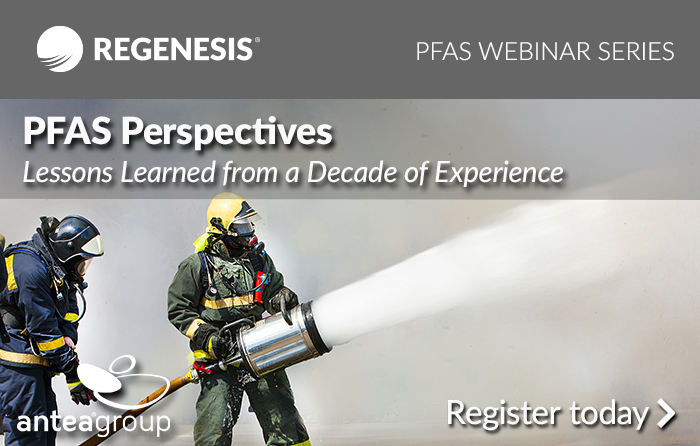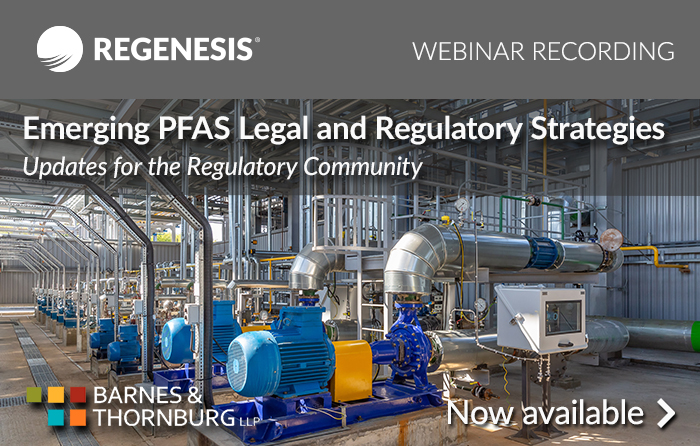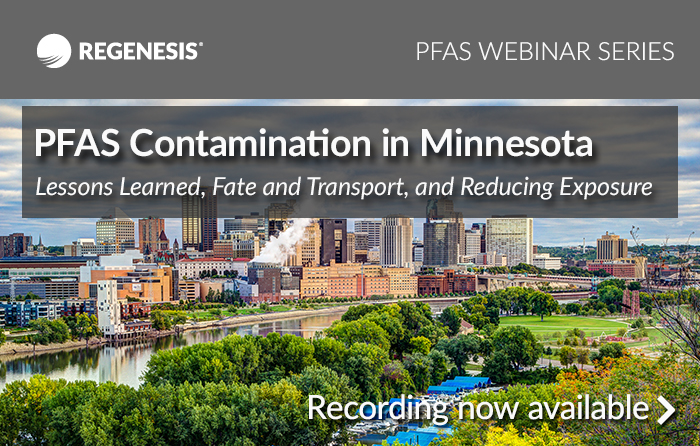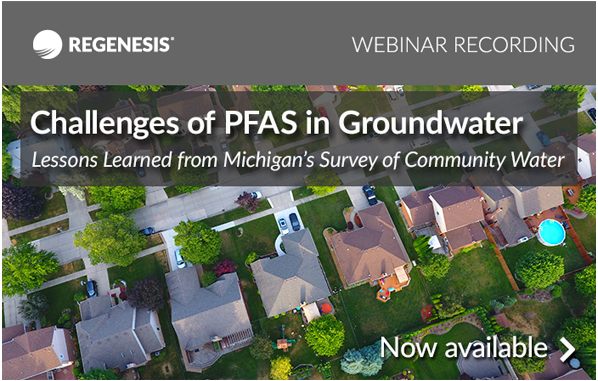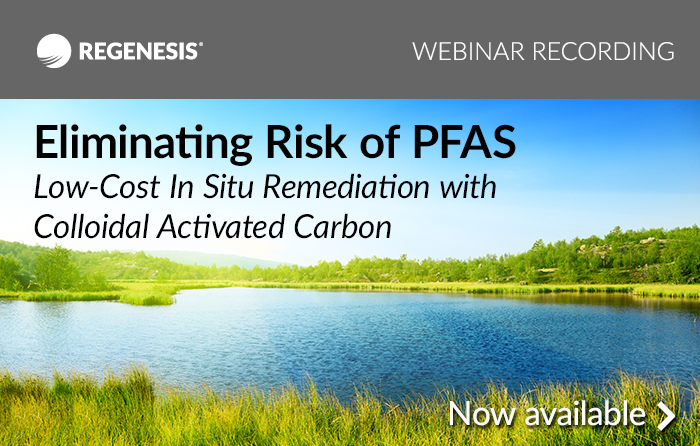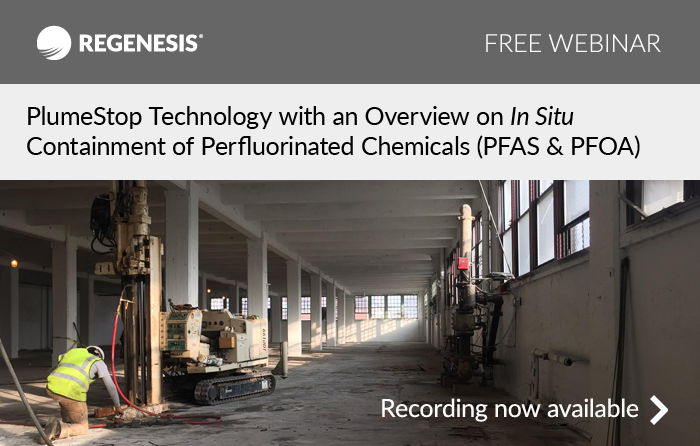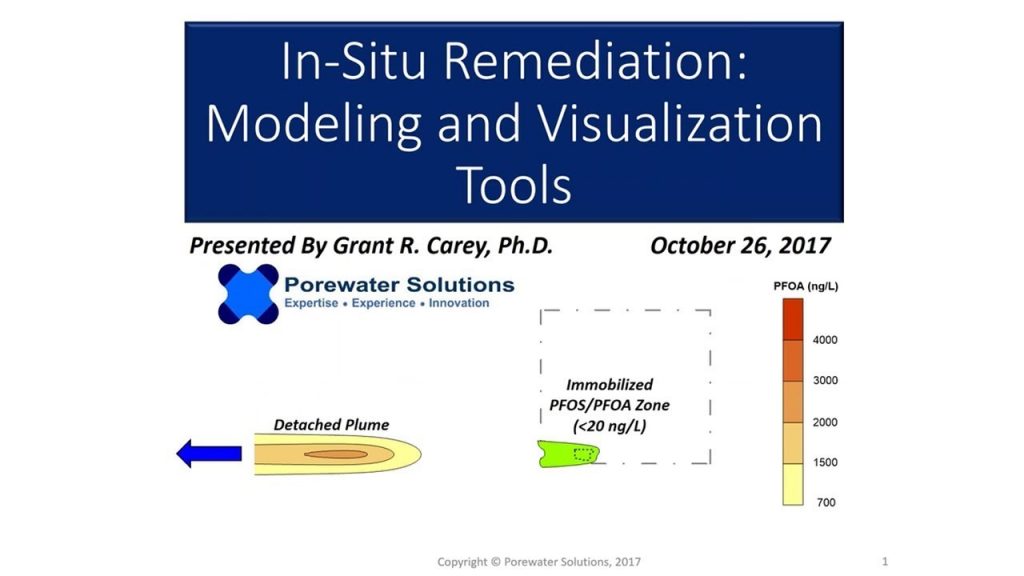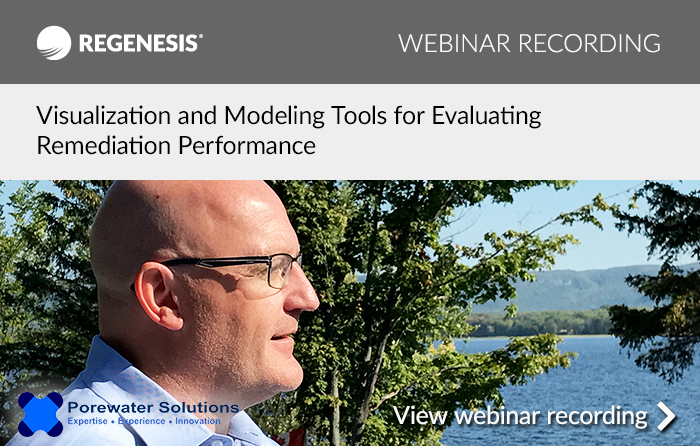PFAS Perspectives: Lessons Learned from a Decade of Experience
In this webinar we were pleased to have as a special guest speaker Jack Sheldon, Senior Remediation Specialist at Antea Group, and Caron Koll, PG, LSP, and PFAS Lead at Antea Group. Their presentation discussed lessons learned from a decade of experience working with PFAS contaminants in groundwater. Through more than a decade of developing sampling programs and interpreting PFAS analytical data, many lessons have been learned and this webinar will focus on a few of those lessons. They were joined by Kristen Thoreson PhD, VP of Research and Development at REGENESIS, who discussed eliminating risk from PFAS via low-cost, in-situ remediation with colloidal activated carbon.
Highlights of this free webinar:
- How to create a custom sampling program, demonstrated by a case study of an environmental site
- A method you can use to sort the chaos out of your data
- How to determine whether a product contains PFAS by looking at a Safety Data Sheet (SDS)
View this free webinar
Emerging PFAS Legal and Regulatory Strategies: Updates for the Regulatory Community
In this webinar we are pleased to have as a special guest speaker Charles M. Denton, Esq., partner at Barnes & Thornburg LLP and immediate past chair of the firm’s national Environmental Law Department. Charles Denton provides an overview of the emerging legal and regulatory considerations for PFAS contamination and key topics for the regulatory community, including businesses and local governments. He is joined by Chad Northington, Southeast District Technical Manager at REGENESIS, who will discuss low-cost, in situ remediation of PFAS using colloidal activated carbon.
Highlights of this free webinar:
- What are the likely sources of PFAS compounds?
- What are the PFAS exposure pathways of concern?
- How are PFAS compounds regulated, and what’s next?
View the recording of this free webinar
PFAS Contamination in Minnesota: Lessons Learned, Fate and Transport, and Reducing Exposure
In this webinar we are pleased to have a special guest presentation by Virginia (Ginny) Yingling, Senior Hydrogeologist in the Environmental Health Division of the Minnesota Department of Health. Ginny discusses PFAS contamination in Minnesota, including lessons learned from the state’s investigation of a chemical production facility, contaminant fate and transport, and reducing exposure. She is joined by Kristen Thoreson, PhD, Director of Research and Development at REGENESIS.
Learn the following in this free webinar:
- State of Minnesota’s investigation of an area of PFAS-contaminated groundwater that covers over 150 sq. miles
- Challenges faced by Minnesota Department of Health in communicating the risk of PFAS to the public
- Lessons learned, key aspects of unique PFAS fate & transport behavior observed, and successes in reducing exposures
- How to eliminate risk of PFAS via low-cost in situ remediation using colloidal activated carbon
View this free webinar
Challenges of PFAS in Groundwater: Lessons Learned from Michigan’s Survey of Community Water
In this webinar we are pleased to have a special guest presentation by Steve Sliver of Michigan Department of Environmental Quality. Mr. Sliver will discuss challenges of PFAS in groundwater and lessons learned from Michigan’s survey of community water. Mr. Sliver is joined by Patricia Byrnes Lyman, Investigation/Remediation Manager at Michigan Dept of Military and Veterans Affairs, and Ryan Moore, Great Lakes District Manager at REGENESIS.
Learn the following in this free webinar:
- Discovery of unacceptable levels of emerging contaminants like per- and polyfluoroalkyl substances (PFAS) in a community water supply
- Immediate and longer-term actions to protect public health and ensure a reliable supply of safe drinking water
- Lessons learned during Michigan’s survey of all its community water supplies in 2018
View this free webinar
Eliminating Risk of PFAS Contamination: Low-Cost In Situ Remediation with Colloidal Activated Carbon
In this webinar we are pleased to have a special presentation by Scott Wilson, President & CEO of REGENESIS. In this presentation he discusses eliminating risk of PFAS contamination in soil and groundwater via low-cost in situ remediation with colloidal activated carbon. By coating flux zones of an aquifer with colloidal activated carbon, a permeable sorption barrier is created in situ, purifying groundwater as it passively migrates.
View the recording of this free webinar
Caso di studio: Contenimento in situ di PFAS mediante PlumeStop Liquid Activated Carbon
In questo webinar Marcello Carboni, Mediterranean District Manager di REGENESIS, discuterà della capacità del PlumeStop® Liquid Activated Carbon di trattare in modo vantaggioso i composti perfluorurati (PFAS), compresi PFOS e PFOA. Introdurrà le caratteristiche di questi contaminanti complessi, illustrerà come il PlumeStop adsorbe in situ i PFAS, discuterà le strategie di contenimento di plume di perfluorurati mediante barriere di iniezione, e presenterà un caso studio di un sito contaminato da PFAS in Canada che è stato bonificato con successo utilizzando il PlumeStop.
Questo sito, un ex stabilimento industriale di produzione di mobili in cui era presente anche una struttura di addestramento antincendio, era in corso di trattamento per la presenza residuale di idrocarburi petroliferi quando delle ulteriori analisi sulle acque sotterranee hanno indicato la presenza in falda anche di PFOA e PFOS. Utilizzando la metodologia direct push, il PlumeStop è stato iniettato insieme all’ORC Advanced® in 50 postazioni nell’acquifero in sabbia limosa al fine di trattare gli idrocarburi petroliferi. Le analisi di monitoraggio post-iniezione su un arco temporale di 18 mesi hanno evidenziato che sia gli idrocarburi petroliferi che PFOA e PFOS sono scesi al di sotto dei limiti di rilevabilità strumentale. Sarà inoltre discusso un sito italiano contaminato da PFAS, dove sono attualmente in corso test batch e in colonna prima di procedere ad un’applicazione pilota in campo.
Presentato da: Marcello Carboni
View webinar recording:
PlumeStop Technology with an Overview on In Situ Containment of Perfluorinated Chemicals (PFAS & PFOA)
First broadcast: February 16, 2017
Speakers: Kristen Thoreson, Ph.D., REGENESIS Research and Development Manager
Recording Available | In this webinar we’re pleased to have Dr. Kristen Thoreson, REGENESIS Research and Development Manager and lead inventor of PlumeStop Liquid Activated Carbon.
Her presentation focuses on PlumeStop and the technology’s ability to treat perfluorinated chemicals, including PFAS and PFOA. The full recording of the presentation is now available to view online.
View webinar recording
Case study: Successful in situ remediation of PFAS using PlumeStop – with Rick McGregor of ISRL
Recording Available | In this webinar we are pleased to have as a special guest speaker Rick McGregor, President of InSitu Remediation Services Ltd. His presentation discusses the in situ remediation of PFOA and PFOS at a site in eastern Canada using PlumeStop® Liquid Activated Carbon™.
This site, a former industrial furniture manufacturing site where a fire training facility was co-located, was being remediated for residue petroleum hydrocarbons when groundwater testing indicated that PFOA and PFOS was present within the groundwater. Using direct push technology, Liquid Activated Carbon along with ORC Advanced® was injected at 50 locations within the silty sand aquifer to address the petroleum hydrocarbons. Post-injection testing over a one-year period indicated that the petroleum hydrocarbons along with the PFOA and PFOS was attenuated to below the applicable method detection limits.
View webinar recording
Visualization and Modelling Tools for Evaluating Remediation Performance
Recording Available| In this webinar, we are pleased to have as a special guest speaker Grant Carey, Ph.D., President of Porewater Solutions. His presentation will demonstrate visualization and modelling tools which may be used to improve the assessment and communication of site remediation activities. Dr. Carey’s presentation will cover the following visualization and modelling tools:
- Visual Bio™ – A free radial diagram tool with unique modifications that now make it easy to visualize where biodegradation is occurring in groundwater. This visualization tool is well suited for evaluating contaminant and redox indicator trends during natural and enhanced attenuation. The methods and benefits of this approach are illustrated for a data-rich site where enhanced bioremediation was successfully implemented.
- ISR-MT3DMS™ – A reactive transport model which was recently updated to simulate the performance of PlumeStop® Liquid Activated Carbon™. Key features required to model the performance and longevity of PlumeStop are demonstrated for a case study application. The benefits of reactive transport modelling for designing a site remedy are also discussed.
Dr. Carey will be joined by Maureen Dooley, Director of Strategic Projects at REGENESIS, who will share her expertise on remediation of complex sites as it relates to the projects and modelling tools featured in Dr. Carey’s presentation.
View webinar recording
Visualization and Modeling Tools for Evaluating Remediation Performance
First broadcast: October 26, 2017
Speakers: Grant Carey, Ph.D. President, Porewater Solutions and Maureen Dooley Director of Strategic Projects, REGENESIS
In this webinar we are pleased to have as a special guest speaker Grant Carey, Ph.D., President of Porewater Solutions. His presentation will demonstrate visualization and modeling tools which may be used to improve the assessment and communication of site remediation activities. Dr. Carey’s presentation will cover the following visualization and modeling tools:
- Visual Bio™ – A free radial diagram tool with unique modifications that now make it easy to visualize where biodegradation is occurring in groundwater. This visualization tool is well suited for evaluating contaminant and redox indicator trends during natural and enhanced attenuation. The methods and benefits of this approach are illustrated for a data-rich site where enhanced bioremediation was successfully implemented.
- ISR-MT3DMS™ – A reactive transport model which was recently updated to simulate the performance of PlumeStop® Liquid Activated Carbon™. Key features required to model the performance and longevity of PlumeStop are demonstrated for a case study application. The benefits of reactive transport modeling for designing a site remedy are also discussed.
Dr. Carey will be joined by Maureen Dooley, Director of Strategic Projects at REGENESIS, who will share her expertise on remediation of complex sites as it relates to the projects and modeling tools featured in Dr. Carey’s presentation.

 Americas
Americas Europe
Europe Français
Français Deutsch
Deutsch Italiano
Italiano Español
Español